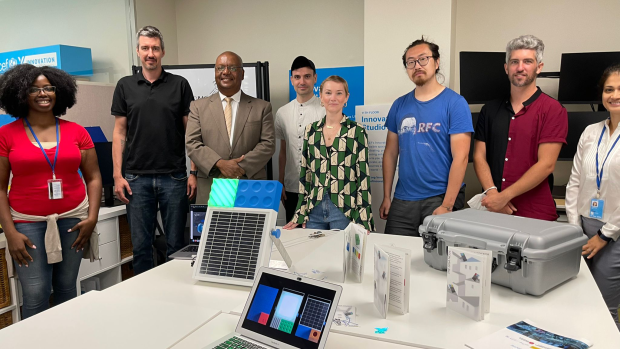Connecting the dots: bringing the internet to the places that need it most
NYU Researchers are helping ensure that students around the world have access to the internet.

From Left to Right: Zakeya Warren, Giga; Christopher Fabian, Giga; Fayaz King, UNICEF; Pedro Oliveira, NYU Tisch School of the Arts; Benedetta Piantella, NYU Tandon; Myf Ma; Alex Nathanson, NYU Tandon; Aditi Poddar, Giga.
In a world where internet connectivity is becoming increasingly essential to prosperity, ensuring students have access to the internet is critical. Yet in 2021, an estimated 2.9 billion people were still offline. Ninety-six percent of them live in low and middle-income economies. And when the COVID-19 pandemic made in-person learning impossible, around 463 million children were left without access to remote learning. These vulnerable populations were being denied key tools in the fight against systemic poverty.
A major project from a UNICEF-ITU partnership called Giga is undergoing a project surveying internet connectivity across the planet and supporting governments to get schools connected to the internet. Since its launch in 2019, Giga has made remarkable progress toward its objective. The program has mapped over 1 million schools across 42 countries in order to figure out where connectivity issues reside and what technologies could be used to connect them.
While the mapping project was underway, however, officials with Giga had a problem. It was one thing to measure connectivity at schools a few times. They needed a way to continuously monitor connectivity speeds in schools and collect that data. To do so, they turned to Benedetta Piantella.
Piantella, an Industry Associate Professor in the Technology, Culture and Society department at Tandon, focuses her research on applying participatory design methods, systems thinking and user-centered design towards the creation of resilient networks, IoT devices, real-time monitoring systems and distributed infrastructure, to ensure equitable access to life-sustaining resources. She had previously collaborated with UNICEF on prototypes for other projects.
This new project, Giga, had some very specific needs. The device would have to constantly monitor connectivity, collect and store that data, be usable in places where even electricity could be unreliable, and be easily readable to administrators at the school themselves. To produce a prototype, Piantella teamed up with Alex Nathanson, adjunct professor of Technology Culture and Society, and Pedro Oliveira of the Tisch School of the Arts, as well as Integrated Design & Media graduate students Natalya Brill and Aakruti Lunia. They worked together with Myf Ma, a longtime collaborator and software developer, and were in direct communication with Christopher Fabian and Naroa Zurutuza of UNICEF/ Giga.
The result of their design process is the Giga Node. Their prototype communicates the level of connectivity experienced by schools around the Globe with the objective of promoting transparency, accountability, and access in all schools connected through Giga. About the size of a coffee-table book, the design utilizes easy-to-acquire parts to monitor and report internet connectivity, both to Giga and to local users.

The Giga Node monitors internet connectivity through a firmware capable of capturing data about the Internet, at the school (such as upload/download speeds, latency, and more) and permanently stores this information online. To make sure the information is reliable, it runs a Blockchain node of a decentralized platform and social network called Scuttlebutt, used to keep an immutable record of the Giga Node monitoring activity. Taken as a whole, it could provide Giga with a map of connectivity, quickly indicating trouble spots where intervention may be necessary. It also offers easily readable LED lights, so school administrators can monitor how strong their internet connection is at a glance and ensures that internet service providers are living up to their contractual obligations and provide value for money for the investment made.
Additionally, the Giga node generates a WiFi Hotspot that extends free wireless connectivity not only to students but also to the surrounding community, bringing more people and local stakeholders direct benefits.
The device runs both on and off-grid. Its power supply can be recharged through grid power as well as renewable energy through a solar panel installed on the front of the unit. It can even be adjusted and angled to take advantage of the most sun exposure. This ensures that even if electricity is spotty, it will still be able to deliver the necessary data.
With the design delivered, UNICEF is now deciding how it will be used in its extensive mapping program. The prototype's design is also available as an open-source project, meaning that anyone with access to simply sourced components can create their own version. The device is designed in such a way that parts are easily replaceable to minimize maintenance costs.
Beyond the Giga project, Piantella imagines it could be used much closer to home — even here in New York City, where there are wide disparities in internet access. Neighborhoods with low Internet penetration where nearly 40% of the households lack access to high-speed Internet could benefit from using Giga node to monitor the quality of connectivity. This could be one more tool to help these communities advocate for themselves and ensure that they have adequate access to a connected world.




